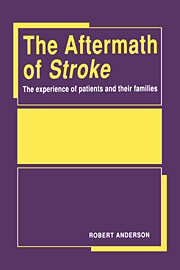Book contents
- Frontmatter
- Contents
- Acknowledgements
- Chapter 1 Stroke: An introduction to the problem
- Chapter 2 The Greenwich stroke study
- Chapter 3 Coming into medical care: the first month after stroke
- Chapter 4 Hospital care and rehabilitation
- Chapter 5 Survival, physical disability and health
- Chapter 6 Support in the community
- Chapter 7 The effects of stroke on social, family and personal life
- Chapter 8 Caring and coping with stroke
- Chapter 9 Resources for coping with stroke
- Appendix: Measurement and scoring of variables
- References
- Index
Chapter 2 - The Greenwich stroke study
Published online by Cambridge University Press: 07 October 2011
- Frontmatter
- Contents
- Acknowledgements
- Chapter 1 Stroke: An introduction to the problem
- Chapter 2 The Greenwich stroke study
- Chapter 3 Coming into medical care: the first month after stroke
- Chapter 4 Hospital care and rehabilitation
- Chapter 5 Survival, physical disability and health
- Chapter 6 Support in the community
- Chapter 7 The effects of stroke on social, family and personal life
- Chapter 8 Caring and coping with stroke
- Chapter 9 Resources for coping with stroke
- Appendix: Measurement and scoring of variables
- References
- Index
Summary
The aim of the Greenwich stroke study was to identify and follow the experiences of a population of stroke patients and their supporters, looking especially at the nature of their problems and at how they were helped to cope with these problems. The study is, therefore, intended to increase understanding about both the quality of support and the quality of life of stroke patients and their carers.
Greenwich health district in London was identified as a suitable area for the study for several reasons: the boundaries of the health authority were coterminous with those of the local authority, thus making it possible to specify the statutory services available in the area; services included a specialised stroke unit, as well as support groups for both patients and carers; it was estimated that the district's population of about 216 000 would generate an adequate number of stroke patients during the course of the study; and, most importantly, several of the district's main service providers had expressed support for the research.
Greenwich forms a triangle to the south of the River Thames, the river running for 14 kilometres along its northern boundary. The triangle contains contrasting social conditions, ranging from areas of comfortable owner-occupied houses to pockets of high unemployment and overcrowding. At the time of the study the local authority was having its income from local tax reduced by the government for overspending, while the health authority's budget was being reduced relative to other health districts because it was more than 20% overfunded in relation to the targets of the Resource Allocation Working Party.
- Type
- Chapter
- Information
- The Aftermath of StrokeThe Experience of Patients and their Families, pp. 13 - 31Publisher: Cambridge University PressPrint publication year: 1992



